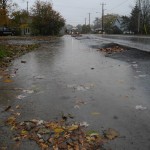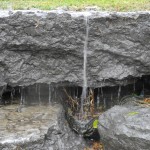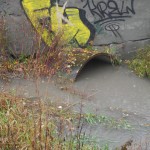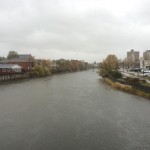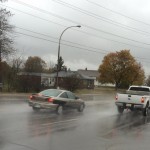Remnants of Hurricane Patricia hitting Quinte
By Mark Hodgins, Taylor Broderick and Tara Henley
BELLEVILLE – UPDATE: The executive director for the Hastings Prince Edward Mental Health Association, Sandy Sidsworth, said her entire office is trying to get water out of one of the association’s four transitional homes.
The 10-bed unit has two sump pumps running trying get water out of the basement, Sidsworth said. The furnaces need to be kept dry in order to keep those in the home warm, she added.
Hurricane Patricia – the monster hurricane that slammed into Mexico’s Pacific coast last week – has lost much of its strength, but it has enough left to dump 45 to 55 millimetres of rain on much of Southern, Central and Eastern Ontario, according to Environment Canada.
https://twitter.com/imawhinney_QNet/status/659405368750116864
A flood outlook statement has been issued by Lower Trent Conservation, while Quinte Conservation has released a water safety statement, saying water levels could rise and become dangerous.
From the statement: “Municipalities and the public should be aware that nuisance flooding is possible in urban areas where storm drains may not be able to handle runoff during heavy downpours or become clogged with leaves. Residents should take care to monitor their sump pumps and ensure they are in good condition and may want to clear gutters and downspouts of leaves. The public is urged to stay away from all waterways as slippery stream banks and cold water conditions are extremely dangerous. Areas around dams, culverts and bridges should be avoided at all times.”
Winds will also be an issue. Gusts of 70 to 90 km/h are possible. A gust of almost 120 km/h was recorded in Prince Edward County:
Now that’s windy! 119 km/h wind gust recorded at Pt Petre, Prince Edward County this hour. #onstorm @weathernetwork pic.twitter.com/axU5uF8NpI
— Lakebreeze PWS WX (@LakebreezePWS) October 28, 2015
Hydro One spokesperson Tiziana Baccega Rofa said, “When you get into a situation with high winds, specifically once they get up past 80 to 100 kilometres, that’s when there could be damage.”
Rofa said that Hydro One “has been monitoring the weather system” as reports come in from Environment Canada: “We’re preparing to best respond if the weather does in fact have any effects on the electricity system.”
According to Rofa, that preparation includes having crews on standby in areas expected to be hit particularly hard.
More to come.
 Print This Post
Print This Post

